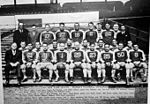1936 NFL Championship Game
The 1936 NFL Championship Game was the fourth championship game played in the National Football League (NFL). It took place on December 13 at Polo Grounds in New York City, making it the first NFL title game held on a neutral field.The Eastern Division champion Boston Redskins (7–5) were the home team, but their owner George Preston Marshall, the Packers and the league mutually agreed to move the game from Fenway Park to the Polo Grounds due to low ticket sales in Boston.Several days after the game, Marshall announced he would move the team to his hometown of Washington, D.C. for the following season.This was the first championship game for both the Redskins and the Western Division champion Green Bay Packers (10–1–1), who were favored. The Packers won 21–6 for their fourth NFL title, all under longtime head coach Curly Lambeau, having previously won league championships awarded by league standing in 1929, 1930, and 1931.
Excerpt from the Wikipedia article 1936 NFL Championship Game (License: CC BY-SA 3.0, Authors).1936 NFL Championship Game
Frederick Douglass Boulevard, New York Manhattan
Geographical coordinates (GPS) Address Nearby Places Show on map
Geographical coordinates (GPS)
| Latitude | Longitude |
|---|---|
| N 40.831 ° | E -73.937 ° |
Address
2
Frederick Douglass Boulevard
10039 New York, Manhattan
New York, United States
Open on Google Maps





